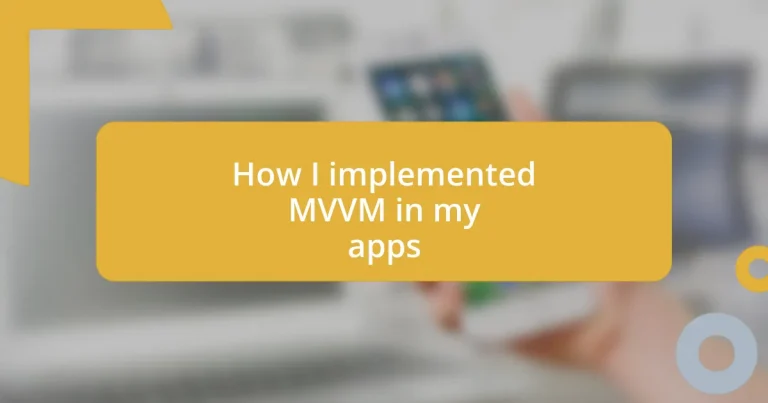Key takeaways:
- MVVM architecture promotes separation of concerns, enhancing code maintainability and scalability.
- Implementing data binding with INotifyPropertyChanged enables real-time UI updates and reduces bugs.
- Using navigation services centralizes navigation logic, improving app structure and user experience.
- Testing with frameworks like NUnit or xUnit boosts confidence in app stability and code quality.
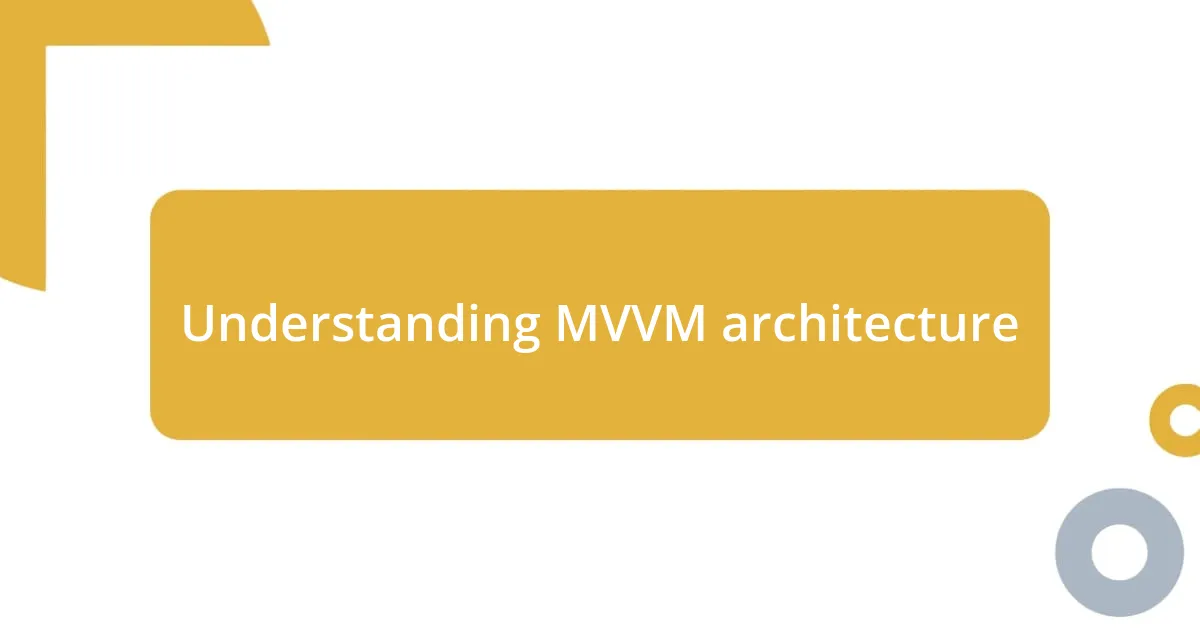
Understanding MVVM architecture
MVVM, or Model-View-ViewModel, is a design pattern that emphasizes separation of concerns, which I’ve found invaluable in my app development. The Model represents the data and business logic, while the View is the UI that users interact with. The ViewModel acts as a bridge, managing the data displayed on the screen and facilitating user interactions.
As I started implementing MVVM in my apps, I noticed a transformative shift in how I structured the code. It was like untangling a messy ball of yarn—after a while, everything flowed more smoothly. I could easily swap out the View or Model without rewriting the entire application, which saved me countless hours of debugging.
Have you ever felt overwhelmed by tangled code? That’s where MVVM shone for me. By clearly differentiating components, I found that I could approach problems with a clearer mind, leading to quicker solutions and more maintainable applications. It’s almost liberating to work with a structure that supports scalability and testing so neatly!
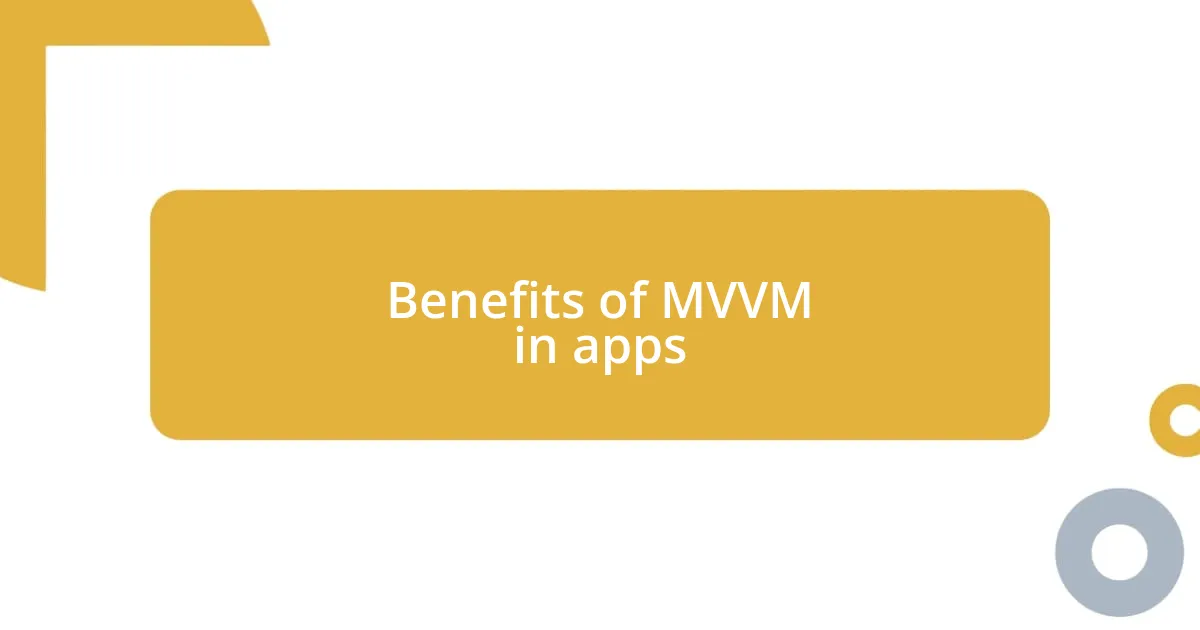
Benefits of MVVM in apps
One of the most notable benefits of implementing MVVM in my applications was the enhanced testability it brought. Previously, I’d struggle to manage unit tests effectively, often finding it tedious to isolate components. With the ViewModel handling data logic separately from the UI, I could easily create focused unit tests, boosting my confidence in the overall stability of my apps. It was such a relief to run tests and see them pass, knowing my application was robust.
Here’s a quick overview of the advantages I’ve experienced with MVVM:
- Separation of Concerns: Each component has a distinct responsibility, making it clearer to manage and understand.
- Easier Maintenance: Changes to the UI or business logic can be made independently without impacting other components significantly.
- Improved Testing: Because ViewModels are isolated, writing unit tests becomes straightforward and effective.
- Enhanced Scalability: As my apps grew, MVVM allowed for smooth integrations of new features without major rewrites.
- Better Collaboration: Teams can work on different aspects (like UI and data) simultaneously, speeding up development.
There was a moment in a recent project where I needed to add a new feature urgently. Thanks to MVVM, I effortlessly created a new ViewModel and hooked it into the existing UI. The process felt seamless, allowing me to focus on delivering quality without the drowning weight of complexity. That instant appreciation for how well-organized my code was truly solidified my belief in MVVM’s benefits.
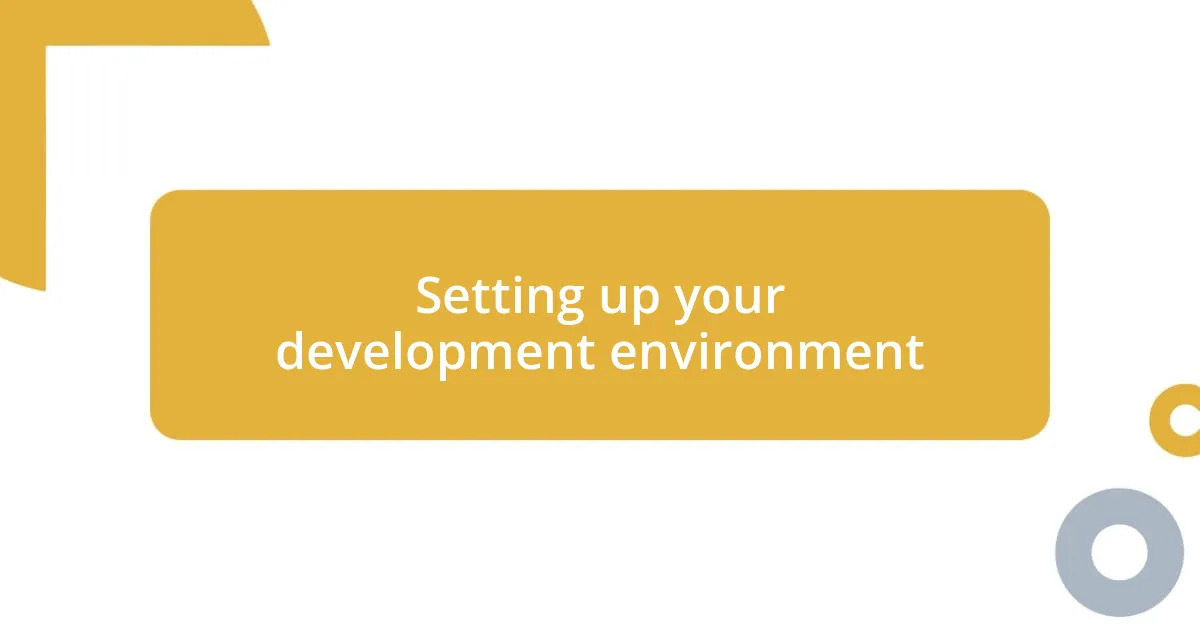
Setting up your development environment
Setting up your development environment is a crucial step before diving into the implementation of MVVM, and I’ve learned this firsthand. I started by installing the necessary tools like Visual Studio and Git, ensuring I had a solid foundation for both coding and version control. It felt empowering to see everything neatly laid out on my screen, ready for action.
I also made it a habit to create a dedicated workspace for each project. This organization saved me a lot of headaches down the line—different MVVM components could be easily located, and I avoided the chaos of mixing projects. Have you ever spent ages searching for a file? That’s a feeling I wanted to avoid!
Lastly, I took some time to configure my IDE plugins for MVVM support. These plugins not only streamlined the development process but also introduced shortcuts that made coding more efficient, almost like having a trusty companion while coding. That extra layer of comfort definitely fueled my motivation.
| Aspect | Details |
|---|---|
| IDE | Visual Studio is ideal for C# MVVM apps, while Android Studio suits Kotlin development. |
| Version Control | Using Git ensures that you can track changes effectively and collaborate with others easily. |
| Plugins | Integrating MVVM-related plugins can speed up your workflow and enhance code quality. |
| Location of Files | Organizing files into separate folders for Models, Views, and ViewModels helps maintain clarity. |
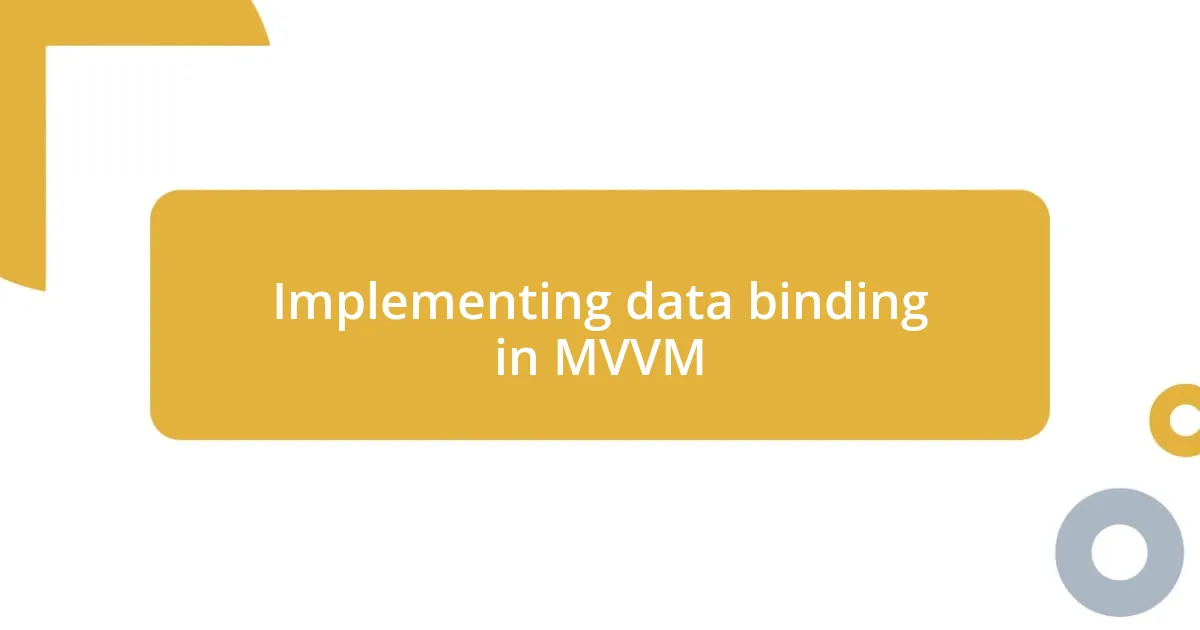
Implementing data binding in MVVM
Implementing data binding in MVVM was a game-changer for me in how swiftly updates reflected in my UI. I remember the first time I set it up; it felt almost magical watching the UI respond instantly to changes in my ViewModel. It’s not just about reducing boilerplate code—it’s about the thrill of syncing data smoothly without the manual effort that used to bog me down.
One thing I found particularly interesting was the use of INotifyPropertyChanged in my ViewModels. Ensuring my models implemented this interface allowed me to notify the Views of any changes automatically. I can’t tell you how satisfying it was to see those updates happen in real time after I made just a few adjustments to my data. This one feature significantly reduced the chances of bugs creeping in, producing a more reliable application overall.
However, I’ve also encountered challenges along the way, especially when integrating third-party components that had different data binding expectations. Have you ever had to wrestle with stray bugs that didn’t seem to make sense? That was my experience when I learned the importance of understanding how different frameworks handle data binding. It motivated me to delve deeper into the intricacies of MVVM, ensuring that I wasn’t just applying it mechanically, but truly grasping its principles. The lessons I took away were invaluable, reinforcing the importance of solid foundational knowledge in delivering a seamless user experience.
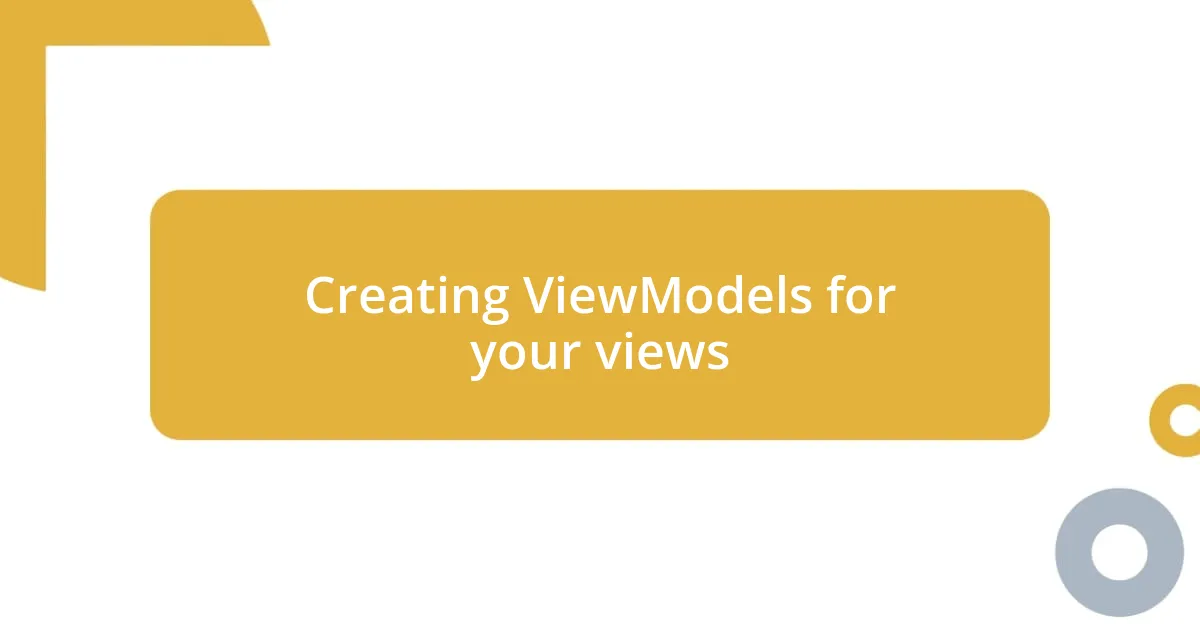
Creating ViewModels for your views
Creating ViewModels for my views was an essential step in embracing MVVM fully. I vividly remember the initial struggle of structuring my ViewModels; it felt overwhelming at first. But once I grasped the principle of keeping them lightweight, focusing solely on handling the logic without any UI dependencies, everything started to fall into place. Don’t you just love that “aha” moment when things click?
As I created ViewModels, I began to appreciate the power of exposing properties and commands clearly. For example, I implemented ICommand for buttons, which allowed for a cleaner separation of concerns. It was fascinating to see how this approach not only organized my code but also made my Views simpler and more reactive. Have you tried this yet? It can feel like clearing clutter from your workspace—suddenly, everything is easier to find and use.
One challenge I faced was ensuring the ViewModels could communicate effectively with each other and the underlying Models. The use of events or messaging systems—like MVVM Light’s Messenger—was a revelation for me. I recall a moment when I had to pass data between two ViewModels, and seeing how effortlessly the communication flowed was incredibly rewarding. This experience taught me that a well-structured ViewModel isn’t just about managing data but also about facilitating interaction. It’s like setting up a smooth conveyor belt in a factory; the more efficiently it runs, the better the overall operation.
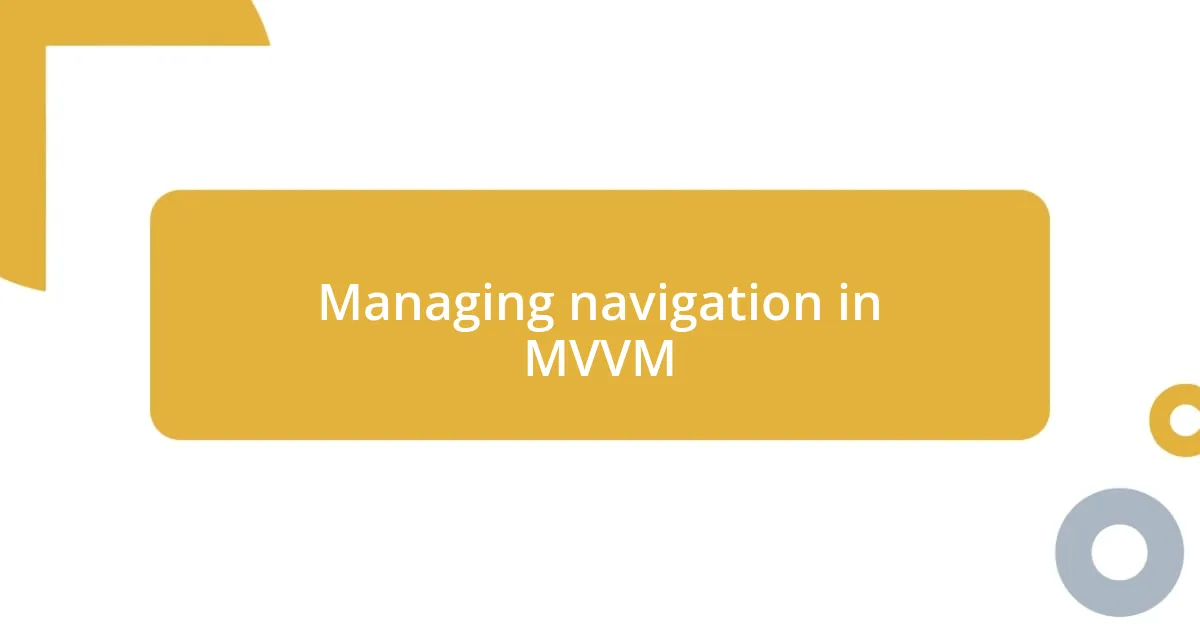
Managing navigation in MVVM
Managing navigation in MVVM was a journey I didn’t expect to be quite so intricate. Initially, I relied heavily on traditional navigation methods, which often led to tangled code and a less-than-ideal user experience. It wasn’t until I embraced navigation services—decoupling the navigation logic from my Views—that I started to see a clearer path. Have you ever felt that sense of clarity wash over you when you finally stumble upon an elegant solution?
One of my pivotal moments came when I implemented a simple navigation service interface. It significantly streamlined navigating between different pages in my app. By using this service, I was able to centralize all my navigation logic, which made it easy to modify routes or transition animations without diving into each ViewModel individually. It’s fascinating how a little restructuring can lead to a more maintainable codebase. The feeling of confidence that comes when adding new views and knowing the navigation will just work? Priceless.
I also learned the importance of passing parameters during navigation. The first time I tackled this, I remember how daunting it felt to inject dependencies or send data to different views. However, once I implemented parameterized navigation, the satisfaction of seeing everything connect seamlessly was exhilarating. I still smile at the thought of how such a small addition allowed my app to feel more dynamic and responsive to user interactions. Embracing these patterns in navigation has truly transformed how users engage with my apps, making it a memorable part of my development journey.
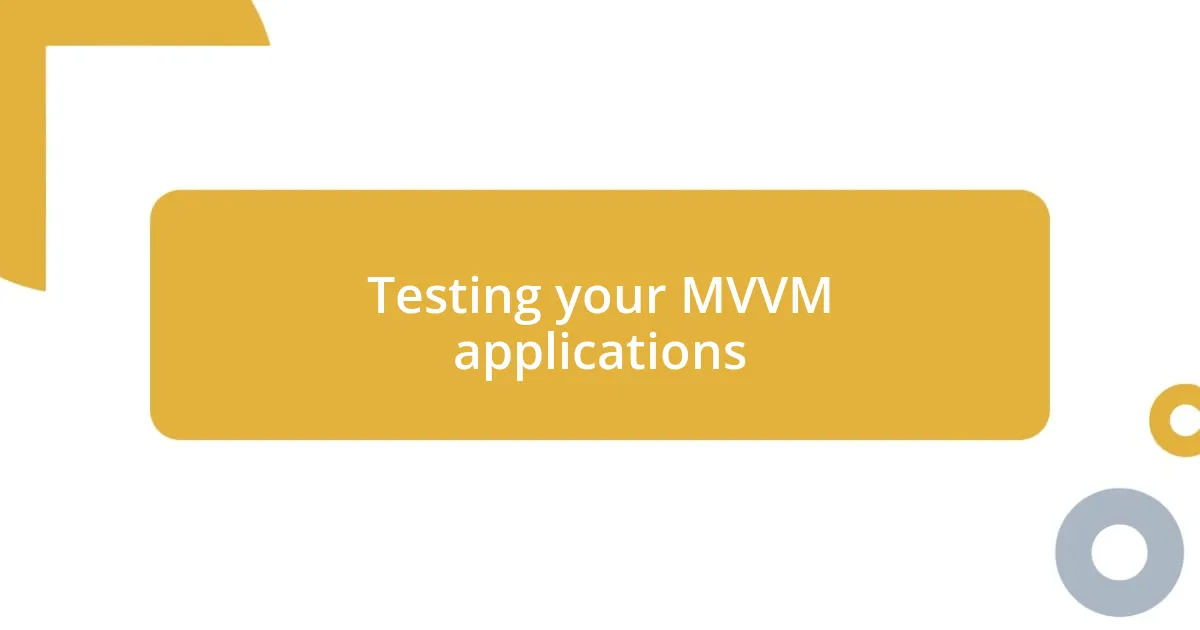
Testing your MVVM applications
Testing MVVM applications can be a game-changer in ensuring that your app behaves as intended. I remember the first time I set up unit tests for my ViewModels; it felt like mastering a new skill. It was refreshing to see that by mocking my Models, I could isolate and validate my business logic without the distractions of the UI. Have you tried mocking yet? It’s like practicing a perfect shot in basketball—you’re honing your skills without the pressure of the game.
While diving deeper into testing, I discovered the benefit of using a framework like NUnit or xUnit. These tools offered a structured way to write and execute my tests, which significantly improved my workflow. There was this moment when I ran my first batch of tests and saw them all pass; the relief and satisfaction were palpable. It struck me how vital tests are for maintaining code quality, especially when making changes later on. It’s empowering to know you have a safety net that catches potential issues before they trickle down to your users.
Integration testing in MVVM was another crucial aspect I delved into. I still recall the innovative approach I took to test the entire flow from a ViewModel to View interaction. By simulating user actions and observing the responses, I felt a profound sense of confidence in my app. The realization that I could mirror real user interactions significantly reduced the stress of deploying updates. Have you experienced that comforting assurance when everything just clicks? It’s moments like these that transform testing from a chore into a vital and exhilarating part of the development process.












